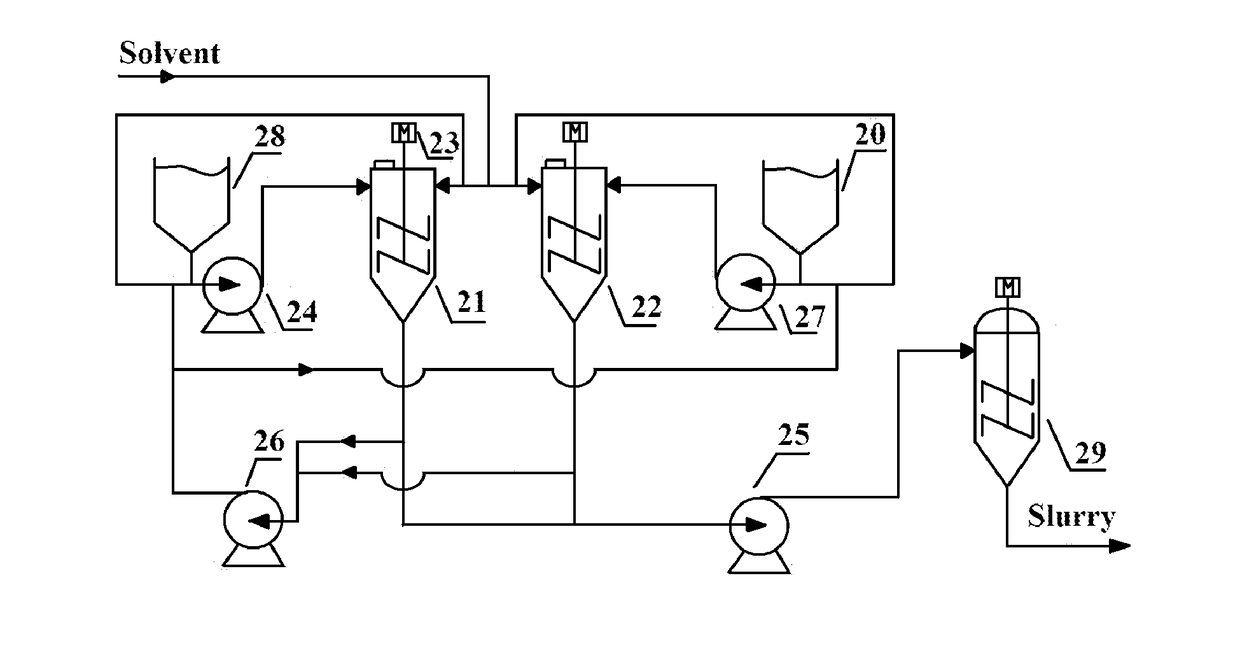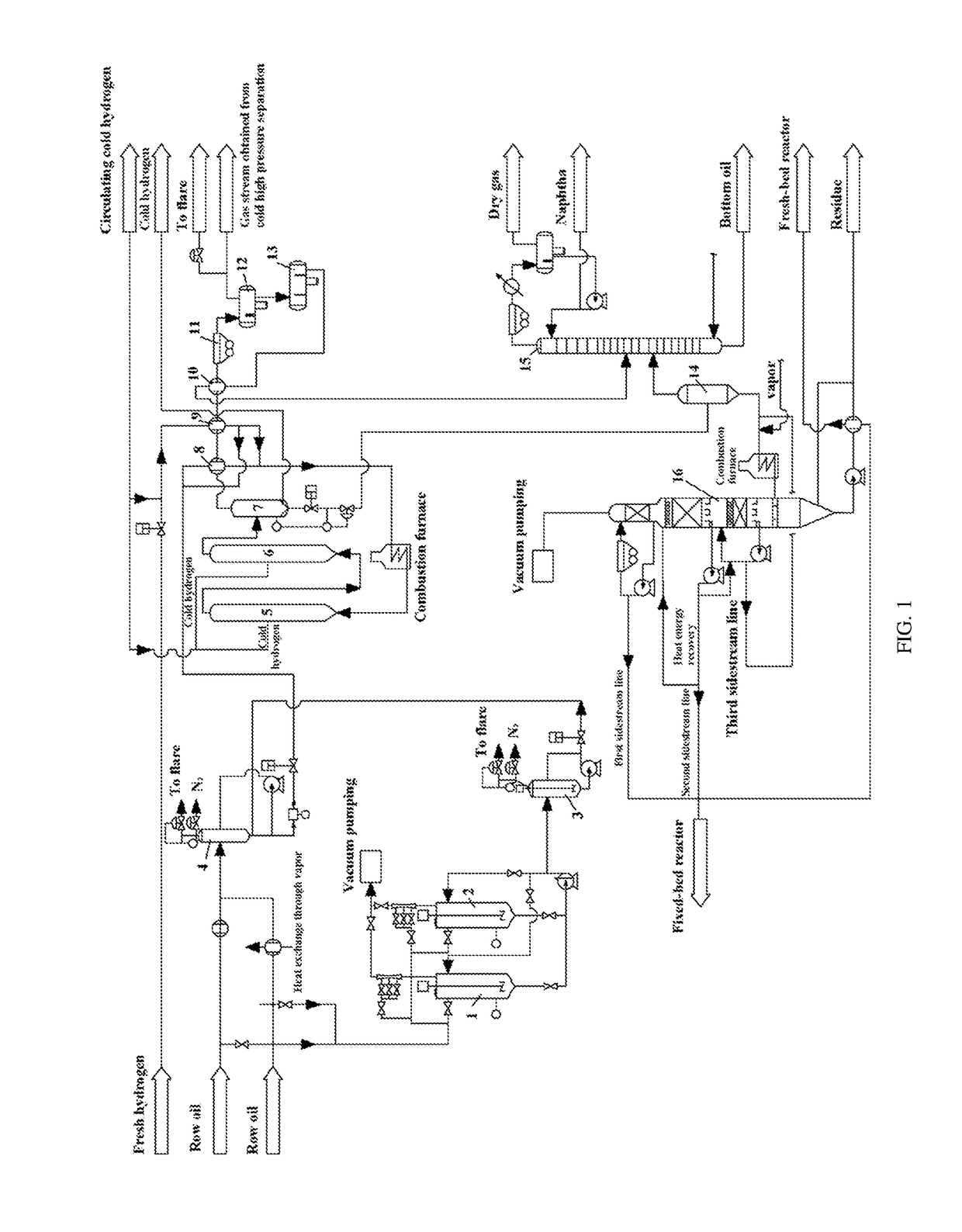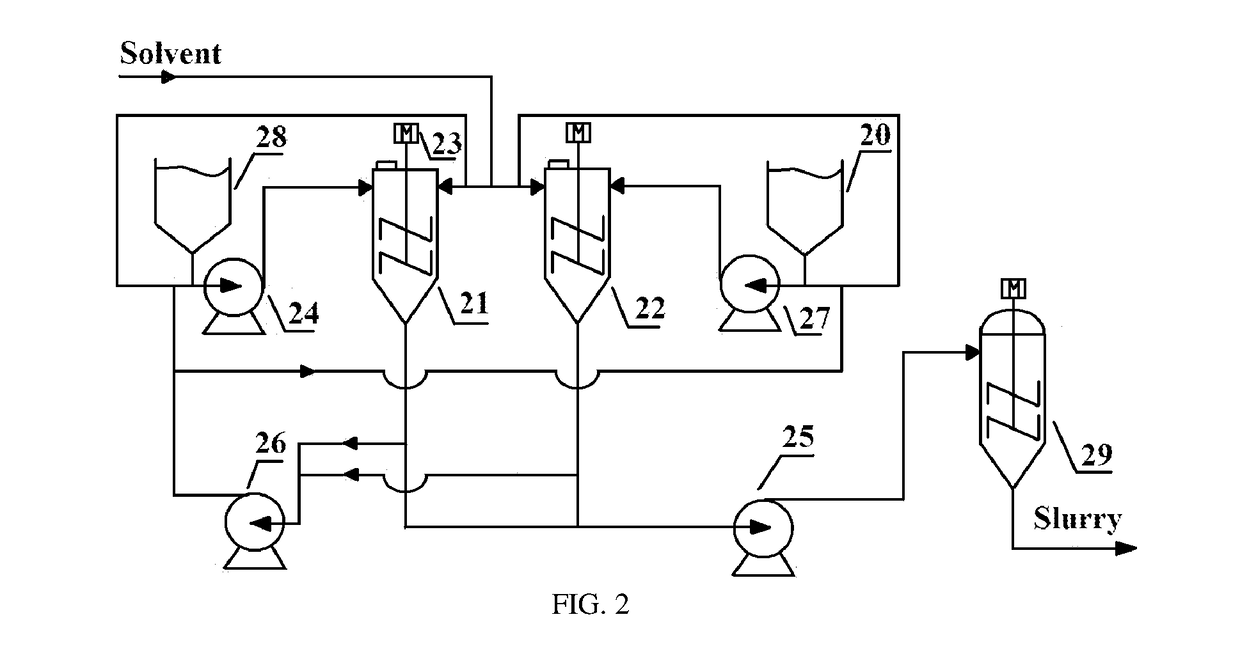Process and Device for Hydrogenation of Heavy Oil Using A Suspension-Bed
a technology of heavy oil and suspension bed, which is applied in the field of processing and device for hydrogenation of heavy oil using a suspension bed, can solve the problems of easy precipitation of catalyst at the bottom, low rapid decline of heavy fuel oil demand, etc., and achieves high yield of light oil product, high yield, and good separation
- Summary
- Abstract
- Description
- Claims
- Application Information
AI Technical Summary
Benefits of technology
Problems solved by technology
Method used
Image
Examples
embodiment 1
[0172]As shown in FIG. 1, the process for hydrogenation of heavy oil using a suspension-bed provided in the present embodiment comprises the following steps:
[0173](1) taking residue oil as a raw oil of the present process, taking half of the residue oil to mix with the suspension-bed hydrocracking catalyst to form a first mixture, and subjecting the first mixture to first shear and second shear in sequence to obtain a catalyst slurry;
[0174](2) mixing the catalyst slurry with the remaining residue oil and hydrogen to form a second mixture and feeding the second mixture into a suspension-bed hydrogenation reactor for undergoing hydrocracking reaction at a pressure of 18 MPa, a temperature of 425° C., and a volume ratio of hydrogen to oil controlled at 1000 to obtain a hydrocracked product; and
[0175](3) after 1.5 h, subjecting the hydrogenated product obtained in step (2) to a hot high pressure separation at 18 MPa and 400° C. to obtain a gas stream and an oil stream respectively; afte...
embodiment 2
[0179]As shown in FIG. 1, the process for hydrogenation of heavy oil using a suspension-bed provided in the present embodiment comprises the following steps:
[0180](1) Purification treatment of coal tar
[0181]Introducing air into the coal tar, conducting backmixing contact between the kaolin powder with a particle size of 0.2 mm and a specific surface area of 50 m2 / g and coal tar in a mass ratio of 0.1:1 and adsorbing at 50° C. and 0.5 MPa, wherein the flow of air required for each 1 kg of kaolin powder is 0.5 m3 / s; performing layered settlement after the adsorption to obtain upper-layer material, then subjecting the upper-layer material to a solid liquid separation, wherein the obtained liquid phase is the purified coal tar;
[0182]compared with the coal tar before purification treatment, the carbon residue in the coal tar after purification in the present embodiment is reduced to 0.1%, reduced by 79%; the content of asphaltene is reduced by 76%; the content of colloid is reduced by 80...
embodiment 3
[0189]As shown in FIG. 1, the process for hydrogenation of heavy oil using a suspension-bed provided by the present embodiment comprises the following steps:
[0190](1) Preparation of catalyst slurry
[0191]Selecting coal tar as the raw oil of the present process, please refer to FIG. 5, taking half of the coal tar and injecting into a solvent buffer tank 51, enabling the coal tar to enter a Venturi tube 56 after it is subjected to buffer by the solvent buffer tank 51 and pressurization by the solvent booster pump 58, meanwhile, feeding the suspension-bed hydrocracking catalyst into the Venturi tube 56 from the solid catalyst feeding system 55, subjecting the coal tar and the catalyst to preliminary mixing in the Venturi tube 56 and feeding the mixture into a slurry preparation tank 52, and forming first-level slurry under the stirring effect of the stirrer 54, wherein the temperature in the preparation tank is 90° C. and the pressure therein is normal pressure; and subjecting the first...
PUM
| Property | Measurement | Unit |
|---|---|---|
| temperature | aaaaa | aaaaa |
| pressure | aaaaa | aaaaa |
| particle size | aaaaa | aaaaa |
Abstract
Description
Claims
Application Information
 Login to View More
Login to View More - R&D
- Intellectual Property
- Life Sciences
- Materials
- Tech Scout
- Unparalleled Data Quality
- Higher Quality Content
- 60% Fewer Hallucinations
Browse by: Latest US Patents, China's latest patents, Technical Efficacy Thesaurus, Application Domain, Technology Topic, Popular Technical Reports.
© 2025 PatSnap. All rights reserved.Legal|Privacy policy|Modern Slavery Act Transparency Statement|Sitemap|About US| Contact US: help@patsnap.com



